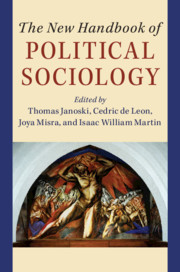Book contents
- The New Handbook of Political Sociology
- The New Handbook of Political Sociology
- Copyright page
- Dedication
- Contents
- Tables
- Figures
- Contributors
- Acknowledgments
- Introduction
- I Theories of Political Sociology
- II Media Explosion, Knowledge as Power, and Demographic Reversals
- III The State and Its Political Organizations
- 15 The Political Economy of the Capitalist State
- 16 States as Institutions
- 17 Nation-State Formation
- 18 The Political Sociology of Public Finance and the Fiscal Sociology of Politics
- 19 Politics, Institutions, and the Carceral State
- 20 The Political Sociology of Democracy
- 21 Revolutions against the State
- IV Civil Society: The Roots and Processes of Political Action
- V Established and New State Policies and Innovations
- VI Globalization and New and Bigger Sources of Power and Resistance
- Index
- References
19 - Politics, Institutions, and the Carceral State
from III - The State and Its Political Organizations
Published online by Cambridge University Press: 22 February 2020
- The New Handbook of Political Sociology
- The New Handbook of Political Sociology
- Copyright page
- Dedication
- Contents
- Tables
- Figures
- Contributors
- Acknowledgments
- Introduction
- I Theories of Political Sociology
- II Media Explosion, Knowledge as Power, and Demographic Reversals
- III The State and Its Political Organizations
- 15 The Political Economy of the Capitalist State
- 16 States as Institutions
- 17 Nation-State Formation
- 18 The Political Sociology of Public Finance and the Fiscal Sociology of Politics
- 19 Politics, Institutions, and the Carceral State
- 20 The Political Sociology of Democracy
- 21 Revolutions against the State
- IV Civil Society: The Roots and Processes of Political Action
- V Established and New State Policies and Innovations
- VI Globalization and New and Bigger Sources of Power and Resistance
- Index
- References
Summary
Carceral states rely on incarceration of an exceptionally large number of their citizens, typically accompanied by a diversity of supplemental methods of criminal justice control. The United States of the late twentieth and early twenty-first century is such a carceral state. In the words of political scientist Marie Gottschalk (2015: 1): “a tenacious carceral state has sprouted in the shadows of mass imprisonment and has been extending its reach far beyond the prison gate. It includes not only the country’s vast archipelago of jails and prisons, but also the far-reaching and growing range of penal punishments and controls that lies in the never-never land between the prison gates and full citizenship.” And indeed, jails and prisons in America today are supplemented by expanding probation and parole systems, community sanctions, drug courts, immigrant detention and deportation, public stigmatization of released sex offenders, and the disenfranchisement of ex-felons.
- Type
- Chapter
- Information
- The New Handbook of Political Sociology , pp. 513 - 537Publisher: Cambridge University PressPrint publication year: 2020

